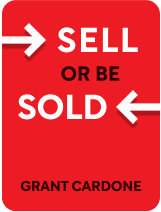

This article is an excerpt from the Shortform book guide to "Sell or Be Sold" by Grant Cardone. Shortform has the world's best summaries and analyses of books you should be reading.
Like this article? Sign up for a free trial here .
What is the book Sell or Be Sold about? What does it take to become a master salesman?
Sell or Be Sold explores the experiences of Grant Cardone, the author, during the course of his 25 years as a salesman. He seeks to teach readers about the principles and skills required to become a master salesman. You can become a master salesman by having a sales mindset, getting sales training, and developing an effective sales process.
Read on to learn more about the secrets of salesmanship explored in Sell or Be Sold.
The Overview of Sell or Be Sold
In Sell or Be Sold, sales consultant and trainer Grant Cardone shares his 25 years’ worth of experience working as a salesman and his life’s worth of experience selling in a personal context.
Whether or not you’re officially employed as a salesperson, your happiness and even survival depend on your selling ability. Anything you do to get your own way—influencing, persuading, negotiating, or even just communicating—is selling. For example, you have friends because you successfully convinced people to spend time with you.
Becoming a Master Salesperson
Since sales is so important to success, it pays to get good at it. Grant in Sell or Be Sold outlines five steps to becoming a master salesperson:
Step #1: Commit. Put all of your time, resources, and energy toward sales and success. To do this:
- Mythbust your negative perception of sales (if necessary). You might have heard that selling is unstable or dishonest, but in reality, selling is a noble, respectable, important job that has several benefits such as control over your own hours and good money.
- Get over your dislike of selling (if necessary). The only reason people don’t like doing things is that they’re bad at them—feeling incompetent and powerless makes them uncomfortable. Once you learn how to sell (in step #2), you’ll feel perfectly comfortable.
- Stop looking for and eliminate other career options. This will force you to commit.
- Regularly remind yourself of your commitment. For example, Cardone wears a pin that says “100%” to remind himself of his commitment.
- Think of success as a duty, obsession, and ethical requirement—if you ever see success as something optional or that will “just happen,” you’ll never reach it.
- Take responsibility. Decide that whether or not someone buys is completely dependent on you, not them. Don’t make excuses or attribute things to luck.
- Take “massive action.” When you want something, put in at least 10 times more effort than you think you need, and be unreasonable and insane. A good example of this in Sell or Be Sold was when Cardone was working on a client, he called him 15 times in 72 hours even though the client never returned his previous calls.
Step #2: Train. A good training program must be both theoretical and applied. To train effectively:
- While you’re driving, Grant in Sell or Be Sold suggests listening to audio programs about sales. Choose programs with concrete information (for example, how to handle an objection) rather than motivational programs.
- Role-play scenarios that make you uncomfortable or that you have trouble succeeding in.
- Take notes or record your interactions with customers so you can analyze them.
- Consult Cardone’s resources such as his video segments, other books, or coaching (payment required).
- Learn about your products. You need to be able to answer questions about the product and tell customers about its features and value proposition.
- Train every day, ideally before and during the day so you can use your training as a warm-up for real sales situations.
- When you lose a customer to a competitor, analyze why the competitor or product might have appeared more attractive than your offer. You can even ask a colleague, ideally a manager, to call the client and ask why she didn’t buy from you.
Step #3: Adopt a positive attitude. People are motivated by the need to feel good, and they prioritize positive interactions over product features, which means that if your attitude is good, you can sell products that are more expensive and less cutting-edge than your competitors’. There are a couple of ideas in the Sell or Be Sold book to help you adopt a positive attitude:
- Avoid negative influences such as media and people with bad attitudes.
- Practice eliminating negative thoughts. Actions stem from thoughts, so if you can control your thoughts, you’ll be able to control the actions that shape your life. Try the following exercise: For 24 hours, don’t let any negative thoughts enter your mind and don’t do any negative actions (such as badmouthing). If you don’t last 24 hours, write down the negative thought or action that derailed you and restart the exercise.
Step #4: Manage your time with discipline. You should treat time like money and use it wisely. To do this:
- Connect with customers at lunch. (Don’t go for lunch with your coworkers—they’re never going to buy anything from you.) Either schedule a lunch meeting with customers or go to restaurants and strike up conversations with people who could become potential customers.
- Avoid things that waste your time such as calling your family, daydreaming, or taking coffee breaks. You’ll have time to relax and to spend with your loved ones after you’ve become successful.
- Use social media efficiently. Social media can be a time-waster, but having a presence is critical to sales because it allows customers to connect with you. Today, most people’s first step to making a purchase is to research it online. Take your social media reputation seriously, and respond promptly and professionally to any negative reviews.
Step #5: Sell to yourself first. Sell or be Sold emphasizes the importance of knowing how to sell yourself. Before you can sell someone on something, you first have to sell yourself on it, because if you don’t believe in the product, buyers will sense your lack of conviction and won’t make a purchase. To sell yourself:
- Be unreasonable in your conviction that what you’re selling is superior. Never even let it cross your mind that there might be something out there that can compete with your product.
- Ignore any negatives associated with your product and concentrate only on the positives.
- Be willing to buy the product yourself at the price you’re asking. If you believe that the product is guaranteed to work out (as you will need to, to be sold on it), then you should have no trouble using all your savings or going into debt to buy it.
- Believe that not buying your product from you is the worst decision of someone’s life. You must think that failing to convince her to buy is an unethical disservice that you lose sleep over.
Sell or Be Sold also recognizes that there will be some products you won’t be able to sell yourself on; therefore, you won’t be able to sell them. For example, if you think smoking is unhealthy, you won’t be able to sell cigarettes. This is fine. You don’t need to be able to sell every product to be a good salesperson.
Working With Customers
Now that you’ve worked on yourself, it’s time to work on your customers. There are five steps outlined in Sell or Be Sold:
Step #1: Find customers. There are two ways to do this, and the first is the easiest:
- Sell to the people you already know such as family, friends, and past customers. Because you already have a relationship with these people, you know each others’ needs and wants, and you’re invested in each others’ happiness and success.
- Cold call. Consider what audiences might have the problem your product can solve (for example, if you sell toy cars, you might target parents). Once you’ve decided whom to approach, dispense with fear, dress professionally, and visit them in person.
Step #2: Prioritize people. No matter what you’re selling, Sell or Be Sold emphasizes that your priority should be people. Don’t think of your job as selling products—think of it as helping people make good decisions and solve their problems. To prioritize a customer:
- Give her your full attention. Don’t take calls, answer emails, or let anything else interrupt your time together. Listen to her and be interested.
- Think like the customer to anticipate her wants. This will show the customer that you want to help her.
- Resolve post-sale problems personally. Any time a customer has a problem, it’s an opportunity to provide service. Seek out problems (for example, call to check in on how a product is working out) and handle them. This will also create opportunities for sales in the future.
- Use organizational aids, such as customer relationship management (CRM) tools, to help you remember details about specific customers such as contact information, pet peeves, likes and dislikes, loved ones, colleagues, and anything else you find out.
Step #3: Agree with the customer. Grant Cordone in Sell or Be Sold insists that you must Always agree with the customer, no matter what she says. You don’t have to think she’s right, but you have to at least agree that she thinks she’s right. People like people and ideas they agree with, and they’re more likely to buy from you if they think you’re on the same page. Once you’ve agreed, to make the sale, you can either:
- Convince her of your position or even that hers is wrong. For example, if a customer says a roof is too expensive, agree that new roofs cost a lot of money. Then, point out that they last 30 years and that repairing old roofs is expensive too.
- Give her a chance to handle the objection herself. This will tell you how seriously she objects—if she comes up with a solution on her own, you’ll know that it wasn’t a very serious objection. (Shortform example: If you’re selling a house and the customer says the bedrooms are too small, agree with her. Then, ask her what she thinks can be done about it. If she muses about putting up mirrors to make the space look bigger, you know that she’s not actually that opposed to the square footage.)
Step #4: Establish trust. Lack of trust is a major reason a customer won’t buy something, and she can lack trust in the salesperson (a few unscrupulous people have run scams) or her own ability to make the right choice. If you can demonstrate that you’re trustworthy, you’ll soothe both of her worries—she won’t worry that she’s being scammed, and she’ll have someone to guide her to the right decision. Here are a few ideas in Sell of Be Sold on creating customer trust:
- Assume the customer will only believe what she can see. People believe things that they can observe for themselves far more readily than things people tell them. Additionally, people tend to assume that anything that’s written down is true.
- Facilitate the customer’s research. The more information she’s given, the more likely she is to buy something. Provide Internet access so she can do her own research, your competitors’ ads so she can compare, and as much data on your products as possible.
- Show her proof that you’re telling the truth by supporting everything you say with documentation or something tangible that she can see for herself. For example, when Cardone wanted his friend to invest in a property, he didn’t pitch it. Instead, he asked his friend to meet him at the property. When his friend saw it and all the opportunities it provided, he asked Cardone if he could invest.
- If she asks a question you don’t know the answer to, tell her that it’s a great question and that you’ll find out for her. This demonstrates that you’re helpful and service-oriented.
- Put negotiations and promises on paper as part of a buyer’s order.
Step #5: Follow up and/or keep in touch. Regardless of whether a customer makes a purchase or not, keep in touch with her. Here are some tips:
- Use customer relationship management (CRM) tools to keep track of people’s contact information. Being organized will help you remember whom to talk to when.
- Remember your conviction. Your product is so good that absolutely everyone needs it, so keep telling people about it.
- Stay interested. Cardone has some clients he followed up with for 10 years before they bought something.
- Don’t assume that someone who doesn’t return your call isn’t interested. Keep calling, or use a different communication method, until you get traction.
Sales Processes
Now that we’ve worked on ourselves and our customers, we’ll learn about sales processes—step-by-plans to lead the customer to make a purchase.
Sell or Be Sold states that good sales processes should be:
- Short. Customers want to get in and out fast, so the process should only take as long as a customer needs to become comfortable making a purchase.
- Up-to-date. Sales processes need to take into account the fact that today it’s easier to access information, people are busier, and marriages are more equal and both parties have incomes and make decisions.
- Transparent. If you can’t advertise your sales process because it would horrify people (for example, step two is to flat-out lie to the customer), then there’s something wrong with it.
- Customer-focused. Sales processes should be most convenient for the customer because she’s the one making the purchase. They should prioritize salespeople second and management last.
Universal Five-Step Sales Process
Cardone in Sell or Be Sold shares a five-step sales process that works in any industry:
1. Greet the customer. This is a short step that involves exchanging names, making a quick, good first impression, and making the customer feel comfortable. Approach the customer, smile, thank them for seeing you, and shake their hand (making physical contact breaks the ice). Then, ask them what information they’d like.
2. Figure out what the customer wants and needs. Do this by asking questions about previous things she’s bought, her motivations, what problems she’s trying to solve, and so on. This step isn’t about selling—it’s about information-gathering. The goal is to find out which product to show the customer and which features to highlight.
- For example, if a customer wants a glass of water, is it to make her place settings look pretty, because she’s thirsty, or to flush an irritant out of her eye? For each of these purposes, you’d highlight a different feature of the water.
3. Present a product. Instead of letting a potential customer choose her product, pick something for her that will meet the wants and needs you determined in step #2. Don’t present all the benefits of a product—highlight the specific features that she’ll be most interested in to save her time.
- For example, if the customer who wanted a glass of water wanted it to set her table, she’s more interested in the aesthetics of the glass than the water inside it.
4. Make an offer. First, ask everyone to sit down. (When you’re standing up, it’s too easy to rely on talking and pitching). Then, show your customer documentation and figures even if she’s not ready to see them. (She needs this information before she can think about making a purchase.) Finally, don’t ask her if she wants to buy—this would give her the opportunity to say no. Instead, ask her to sign the offer or to follow you to the next step.
5. Close. Closing involves handling stalls and objections and Cardone offers a few tips, but for more detailed instructions on closing, he recommends reading his book The Closer’s Survival Guide.
Here are his tips for handling the close:
Tip #1: Recall your own conviction about the product. This will keep you from backing down.
Tip #2: Don’t believe the reasons customers give you for not buying. They’re likely excuses, not actual objections. Particularly don’t believe price objections—price is never anyone’s number-one concern. The real reason people don’t buy is that they aren’t confident that the product is what they need or want. To handle a price objection, you might:
- Offer the customer a more expensive product. If she can’t afford the original product, seeing the more expensive one will make the first one seem more affordable. If she considers the second product, you know lack of money wasn’t the issue—there was something else she didn’t like about the first product. Most people would rather buy the right product, even if that involves spending more.
- Demonstrate that the product is worth twice as much as you’re asking. (Shortform example: If you’re selling a food processor for $50, show that it’s actually worth well over $100 by explaining that if a customer prices her time at $50 an hour, if the processor saves her an hour of food prep, she’s getting a lot of value.)
Tip #3: Ask forward questions. If you need information, ask, even if the topic is sensitive (such as why someone can’t put up the money).
Tip #4: Ask for the sale multiple times. Almost no one will buy something without being asked, and most people need to be asked multiple times.
Tip #5: Don’t let yelling or emotional outbursts drive you away. These reactions mean that the customer is close to buying. Don’t take anything personally, stay calm, and stay with the customer.
Tip #6: Visualize the desired outcome. In your mind’s eye, see the customer handing over their money or owning the product.
Tip #7: After you’ve closed, consider offering the customer a second product. It’s easier to get people to spend more money once they’ve already made a purchase because the subsequent purchase confirms that the first purchase was a good decision.
- (Shortform example: After closing your customer on a phone, offer her a phone case—the fact that the phone needs protection will confirm that it’s valuable.)
Tip #8: After each close, write down the objections and details about the interaction so you can use what you learned the next time you close.

———End of Preview———
Like what you just read? Read the rest of the world's best book summary and analysis of Grant Cardone's "Sell or Be Sold" at Shortform .
Here's what you'll find in our full Sell or Be Sold summary :
- How your happiness and even survival depend on your selling ability
- The five steps to becoming a master salesperson
- Step-by-plans to lead the customer to make a purchase






